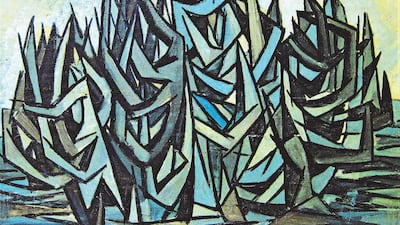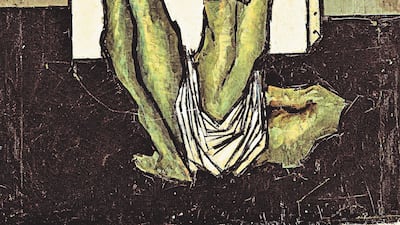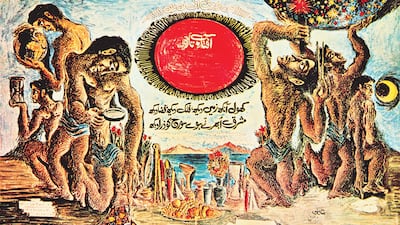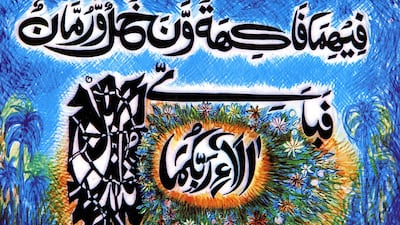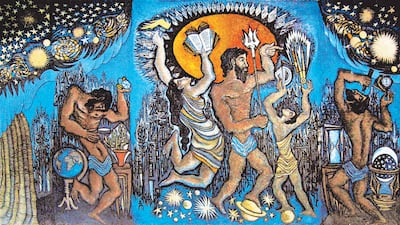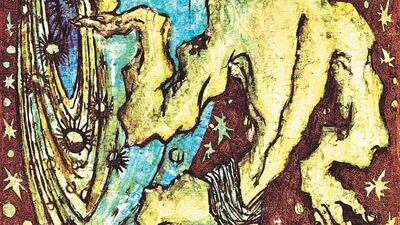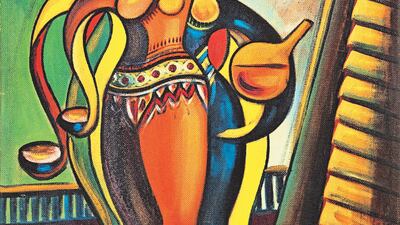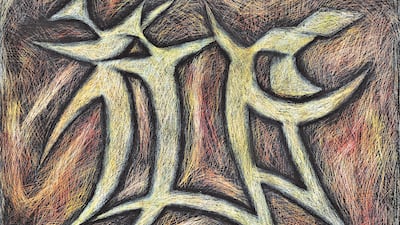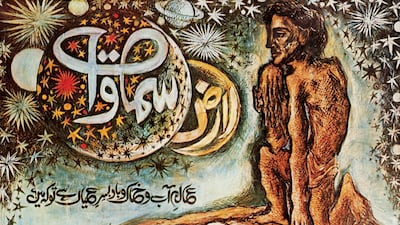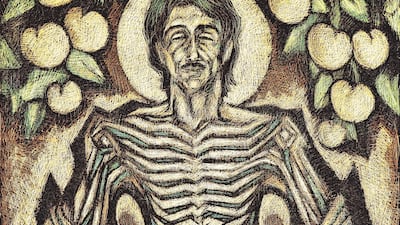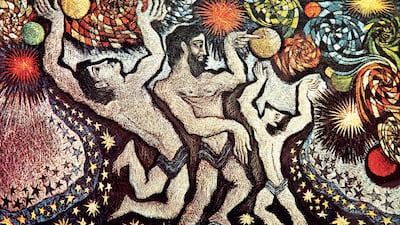We migrated to Pakistan in 1948, about a year after the Partition of India. For some time, all 17 of us in my immediate family lived in a two-bedroom home in Karachi. My father then built Sibtain Manzil, a two-storey house in Nazimabad, an arid strip of land about 10 kilometres from downtown Karachi.
By the time we moved into Sibtain Manzil in 1953, Nazimabad had become both a home to immigrants like us who sought a new life, and a hub for the cultural intelligentsia. And so, it wasn’t surprising to see my uncle, Syed Sadequain Ahmed Naqvi, or Sadequain as he is better known, among the cultural luminaries walking along Nazimabad’s streets.
He was attentive and intuitive and knew how to make someone feel special. He was intellectually astute, a good listener and thinker able to draw crowds in like a gravitational force. People would show up unexpectedly at Sibtain Manzil, eager to have a chat or receive a painting, which Sadequain would dispense freely.
A profoundly generous man, I remember an incident in the mid 1950s when a rickshaw driver without a rickshaw rang the doorbell and asked for help. “How much is a rickshaw?” Sadequain asked. “About 800 rupees sir,” replied the driver. Sadequain promptly bought him a rickshaw. “How can I ever repay you sir?” asked the driver. “Don’t repay me. Just take me to the centre of town tomorrow morning and bring me back in the evening,” replied Sadequain, who later painted a portrait of the driver resting in his rickshaw.
As a child, Sadequain would draw in charcoal on the walls of the family home. No matter how many times he got reprimanded, it didn’t stop him from redrawing and asking family members about their dreams to illustrate. “I was born to paint,” he would tell me. “And I have a photographic memory.”
Though we hail from a family of Quranic scribes, which considered calligraphy an esteemed practice, Sadequain had been told that he couldn’t make a living as an artist. That never deterred him, and his talent was nurtured in the early 1940s when he joined his brother at All India Radio and worked as a calligrapher-copyist. After graduating from Agra University in 1948 and moving to Pakistan, he worked for a time as a college teacher and at Radio Pakistan before committing himself strictly to his artistic practice. Sadequain was also a profound poet and had begun authoring rubaiyat or quatrains in his early years; later, he would illustrate his poems and publish books.
It’s incredible that he mastered and merged painting, calligraphy, poetry and murals. I am fascinated at how he propelled calligraphy as a mainstream art form, producing figures and metaphors from script.
Although he took me to see movies such as Ben Hur and The Longest Day, what I most enjoyed was watching him paint in his bedroom that doubled as his studio. I often fell asleep because it was such a hypnotising experience.
I think Sadequain was a performance artist, too, using his body, mind, paints and canvas to deliver an awe-inspiring artwork. I saw how his letters and forms swirled on his canvases, and I felt that he had a divine connection with them — not solely because some of the text was Quranic, but rather, that the individual letters spoke to his soul. He often described each letter as having its own personality, as though it were a person with good moods or dark temperaments — and he illustrated them as such.
When the painting was complete, it seemed as though Sadequain and his letters morphed, becoming one: an opinionated work of art that celebrated calligraphy and defended the common man. Through his calligraphic figures and landscapes, he always focused on the human condition, addressing moral, political and social issues. It was his mission as an artist.
Sadequain caught the attention of renowned art critic and diplomat Hasan Shaheed Suhrawardy, who introduced him to his brother, Huseyn Shaheed Suhrawardy, prime minister of Pakistan from 1956-1957 and a patron of the arts, and in whose home hung works by Sadequain.
Exhibitions and commissions followed — some patronised by the state — as did a fascination with the work of Picasso, whose influence can be felt in works from the late 1950s and early 1960s. Around this time, Sadequain secluded himself in Gadani and a new element indigenous to the seaside town began to appear in his canvases: cacti, which he adopted as an allegorical symbol of aggression and humanity’s resistance and resilience in the face of hardship.
In 1960, Sadequain was invited by the International Association of Plastic Arts in Paris and won an award at the second Biennale de Paris for a painting he had made at Sibtain Manzil. The biennale subsequently granted him a scholarship, an experience that led to successful exhibitions in France, the UK and the US, and in turn, a wider collector base.
Sadequain regularly wrote to my father and mentioned his struggles and triumphs, and asked about each family member. Of his nieces and nephews, he wrote: “Tell them not to study too hard, tell them to play outside.”
Many believe that his Paris years birthed some of the best works of his career, one of the most significant being a commission to illustrate a new limited-edition of French author and Nobel laureate Albert Camus’s 1942 novel, L’Etranger (The Stranger). In Paris, he painted the city’s scenes in greys and blues, effecting his oeuvre with a greater sense of expressionism and a move towards abstraction. In 1967, he departed Paris abruptly and left behind belongings and paintings. In 2011, I was able to locate more than 500 abandoned paintings in attics, basements and storage facilities.
Sadequain returned to Karachi, and continued to dazzle with his art and spirit, focusing more on calligraphy, publishing his poetry and completing more murals — an art form he had begun in 1955 and in which he completed dozens in Pakistan, India, the Middle East, Europe and North America.
Murals had further cemented his standing as an artist of the people with their empathetic messaging. Notable ones include the monumental The Saga of Labour (1967) for the Mangla Dam powerhouse that pays tribute to labourers, while the 1968 Quest for Knowledge at the Punjab University Library prizes education through its illustration of young men and women holding a "key to learning". Sadly, many murals have either disappeared or been damaged because of neglect, one of which is at Frere Hall, a Venetian-Gothic structure whose ceiling Sadequain had painted, and dedicated to Karachi’s citizens, but which he didn’t complete owing to his untimely death in 1987.
For all his generosity and joie de vivre, Sadequain had a myopic vision as far as his own legacy is concerned. It is tragic that a man who gave so greatly has not been celebrated as much as he deserves. This is why I established the Sadequain Foundation. To date, it has published 25 books on Sadequain and staged more than 100 seminars and exhibitions around the globe. It’s so we don’t forget who spoke for others.
UAE SQUAD
Khalid Essa, Ali Khaseif, Fahad Al Dhanhani, Adel Al Hosani, Bandar Al Ahbabi, Mohammad Barghash, Salem Rashid, Khalifa Al Hammadi, Shaheen Abdulrahman, Hassan Al Mahrami, Walid Abbas, Mahmoud Khamis, Yousef Jaber, Majed Sorour, Majed Hassan, Ali Salmeen, Abdullah Ramadan, Abdullah Al Naqbi, Khalil Al Hammadi, Fabio De Lima, Khalfan Mubarak, Tahnoon Al Zaabi, Ali Saleh, Caio Canedo, Ali Mabkhout, Sebastian Tagliabue, Zayed Al Ameri
Dubai World Cup Carnival card
6.30pm: UAE 1000 Guineas Trial Conditions (TB) US$100,000 (Dirt) 1,400m
7.05pm: Handicap (TB) $135,000 (Turf) 1,000m
7.40pm: Handicap (TB) $175,000 (D) 1,900m
8.15pm: Meydan Challenge Listed Handicap (TB) $175,000 (T) 1,400m
8.50pm: Dubai Stakes Group 3 (TB) $200,000 (D) 1,200m
9.25pm: Dubai Racing Club Classic Listed Handicap (TB) $175,000 (T) 2,410m
The National selections
6.30pm: Final Song
7.05pm: Pocket Dynamo
7.40pm: Dubai Icon
8.15pm: Dubai Legacy
8.50pm: Drafted
9.25pm: Lucius Tiberius
UAE currency: the story behind the money in your pockets
The specs
Engine: 4 liquid-cooled permanent magnet synchronous electric motors placed at each wheel
Battery: Rimac 120kWh Lithium Nickel Manganese Cobalt Oxide (LiNiMnCoO2) chemistry
Power: 1877bhp
Torque: 2300Nm
Price: Dh7,500,00
On sale: Now
The specs
- Engine: 3.9-litre twin-turbo V8
- Power: 640hp
- Torque: 760nm
- On sale: 2026
- Price: Not announced yet
Nepotism is the name of the game
Salman Khan’s father, Salim Khan, is one of Bollywood’s most legendary screenwriters. Through his partnership with co-writer Javed Akhtar, Salim is credited with having paved the path for the Indian film industry’s blockbuster format in the 1970s. Something his son now rules the roost of. More importantly, the Salim-Javed duo also created the persona of the “angry young man” for Bollywood megastar Amitabh Bachchan in the 1970s, reflecting the angst of the average Indian. In choosing to be the ordinary man’s “hero” as opposed to a thespian in new Bollywood, Salman Khan remains tightly linked to his father’s oeuvre. Thanks dad.
ANATOMY%20OF%20A%20FALL
%3Cp%3E%3Cstrong%3EDirector%3A%20%3C%2Fstrong%3EJustine%20Triet%3C%2Fp%3E%0A%3Cp%3E%3Cstrong%3EStarring%3A%20%3C%2Fstrong%3ESandra%20Huller%2C%20Swann%20Arlaud%2C%20Milo%20Machado-Graner%3C%2Fp%3E%0A%3Cp%3E%3Cstrong%3ERating%3A%3C%2Fstrong%3E%205%2F5%3C%2Fp%3E%0A
UAE currency: the story behind the money in your pockets
What is a robo-adviser?
Robo-advisers use an online sign-up process to gauge an investor’s risk tolerance by feeding information such as their age, income, saving goals and investment history into an algorithm, which then assigns them an investment portfolio, ranging from more conservative to higher risk ones.
These portfolios are made up of exchange traded funds (ETFs) with exposure to indices such as US and global equities, fixed-income products like bonds, though exposure to real estate, commodity ETFs or gold is also possible.
Investing in ETFs allows robo-advisers to offer fees far lower than traditional investments, such as actively managed mutual funds bought through a bank or broker. Investors can buy ETFs directly via a brokerage, but with robo-advisers they benefit from investment portfolios matched to their risk tolerance as well as being user friendly.
Many robo-advisers charge what are called wrap fees, meaning there are no additional fees such as subscription or withdrawal fees, success fees or fees for rebalancing.
Brief scoreline:
Crystal Palace 2
Milivojevic 76' (pen), Van Aanholt 88'
Huddersfield Town 0
AI traffic lights to ease congestion at seven points to Sheikh Zayed bin Sultan Street
The seven points are:
Shakhbout bin Sultan Street
Dhafeer Street
Hadbat Al Ghubainah Street (outbound)
Salama bint Butti Street
Al Dhafra Street
Rabdan Street
Umm Yifina Street exit (inbound)
UAE%20ILT20
%3Cp%3E%3Cstrong%3EMarquee%20players%3A%3C%2Fstrong%3E%3Cbr%3EMoeen%20Ali%2C%20Andre%20Russell%2C%20Dawid%20Malan%2C%20Wanindu%20Hasiranga%2C%20Sunil%20Narine%2C%20Evin%20Lewis%2C%20Colin%20Munro%2C%20Fabien%20Allen%2C%20Sam%20Billings%2C%20Tom%20Curran%2C%20Alex%20Hales%2C%20Dushmantha%20Chameera%2C%20Shimron%20Hetmyer%2C%20Akeal%20Hosein%2C%20Chris%20Jordan%2C%20Tom%20Banton%2C%20Sandeep%20Lamichhane%2C%20Chris%20Lynn%2C%20Rovman%20Powell%2C%20Bhanuka%20Rajapaksa%2C%20Mujeeb%20Ul%20Rahman%3C%2Fp%3E%0A%3Cp%3E%3Cstrong%3EInternational%20players%3A%3C%2Fstrong%3E%3C%2Fp%3E%0A%3Cp%3ELahiru%20Kumara%2C%20Seekugge%20Prassanna%2C%20Charith%20Asalanka%2C%20Colin%20Ingram%2C%20Paul%20Stirling%2C%20Kennar%20Lewis%2C%20Ali%20Khan%2C%20Brandon%20Glover%2C%20Ravi%20Rampaul%2C%20Raymon%20Reifer%2C%20Isuru%20Udana%2C%20Blessing%20Muzarabani%2C%20Niroshan%20Dickwella%2C%20Hazaratullah%20Zazai%2C%20Frederick%20Klassen%2C%20Sikandar%20Raja%2C%20George%20Munsey%2C%20Dan%20Lawrence%2C%20Dominic%20Drakes%2C%20Jamie%20Overton%2C%20Liam%20Dawson%2C%20David%20Wiese%2C%20Qais%20Ahmed%2C%20Richard%20Gleeson%2C%20James%20Vince%2C%20Noor%20Ahmed%2C%20Rahmanullah%20Gurbaz%2C%20Navin%20Ul%20Haq%2C%20Sherfane%20Rutherford%2C%20Saqib%20Mahmood%2C%20Ben%20Duckett%2C%20Benny%20Howell%2C%20Ruben%20Trumpelman%3C%2Fp%3E%0A
Know before you go
- Jebel Akhdar is a two-hour drive from Muscat airport or a six-hour drive from Dubai. It’s impossible to visit by car unless you have a 4x4. Phone ahead to the hotel to arrange a transfer.
- If you’re driving, make sure your insurance covers Oman.
- By air: Budget airlines Air Arabia, Flydubai and SalamAir offer direct routes to Muscat from the UAE.
- Tourists from the Emirates (UAE nationals not included) must apply for an Omani visa online before arrival at evisa.rop.gov.om. The process typically takes several days.
- Flash floods are probable due to the terrain and a lack of drainage. Always check the weather before venturing into any canyons or other remote areas and identify a plan of escape that includes high ground, shelter and parking where your car won’t be overtaken by sudden downpours.
Surianah's top five jazz artists
Billie Holliday: for the burn and also the way she told stories.
Thelonius Monk: for his earnestness.
Duke Ellington: for his edge and spirituality.
Louis Armstrong: his legacy is undeniable. He is considered as one of the most revolutionary and influential musicians.
Terence Blanchard: very political - a lot of jazz musicians are making protest music right now.
Our legal columnist
Name: Yousef Al Bahar
Advocate at Al Bahar & Associate Advocates and Legal Consultants, established in 1994
Education: Mr Al Bahar was born in 1979 and graduated in 2008 from the Judicial Institute. He took after his father, who was one of the first Emirati lawyers
World record transfers
1. Kylian Mbappe - to Real Madrid in 2017/18 - €180 million (Dh770.4m - if a deal goes through)
2. Paul Pogba - to Manchester United in 2016/17 - €105m
3. Gareth Bale - to Real Madrid in 2013/14 - €101m
4. Cristiano Ronaldo - to Real Madrid in 2009/10 - €94m
5. Gonzalo Higuain - to Juventus in 2016/17 - €90m
6. Neymar - to Barcelona in 2013/14 - €88.2m
7. Romelu Lukaku - to Manchester United in 2017/18 - €84.7m
8. Luis Suarez - to Barcelona in 2014/15 - €81.72m
9. Angel di Maria - to Manchester United in 2014/15 - €75m
10. James Rodriguez - to Real Madrid in 2014/15 - €75m
FA Cup semi-finals
Saturday: Manchester United v Tottenham Hotspur, 8.15pm (UAE)
Sunday: Chelsea v Southampton, 6pm (UAE)
Matches on Bein Sports
War 2
Director: Ayan Mukerji
Stars: Hrithik Roshan, NTR, Kiara Advani, Ashutosh Rana
Rating: 2/5
The specs: 2017 Ford F-150 Raptor
Price, base / as tested Dh220,000 / Dh320,000
Engine 3.5L V6
Transmission 10-speed automatic
Power 421hp @ 6,000rpm
Torque 678Nm @ 3,750rpm
Fuel economy, combined 14.1L / 100km
Turkish Ladies
Various artists, Sony Music Turkey
If you go...
Etihad Airways flies from Abu Dhabi to Kuala Lumpur, from about Dh3,600. Air Asia currently flies from Kuala Lumpur to Terengganu, with Berjaya Hotels & Resorts planning to launch direct chartered flights to Redang Island in the near future. Rooms at The Taaras Beach and Spa Resort start from 680RM (Dh597).
Banned items
Dubai Police has also issued a list of banned items at the ground on Sunday. These include:
-
-
-
-
-
-
-
-
-
Political flags or banners
-
Bikes, skateboards or scooters
Emergency phone numbers in the UAE
Estijaba – 8001717 – number to call to request coronavirus testing
Ministry of Health and Prevention – 80011111
Dubai Health Authority – 800342 – The number to book a free video or voice consultation with a doctor or connect to a local health centre
Emirates airline – 600555555
Etihad Airways – 600555666
Ambulance – 998
Knowledge and Human Development Authority – 8005432 ext. 4 for Covid-19 queries




